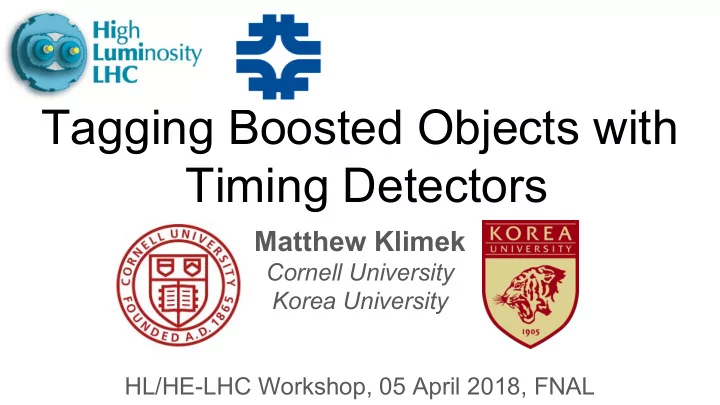

Tagging Boosted Objects with Timing Detectors Matthew Klimek Cornell University Korea University HL/HE-LHC Workshop, 05 April 2018, FNAL
Physics Opportunities Timing Detectors @ HL-LHC Both LHC Experiments are studying new timing detectors for HL-LHC with resolutions ~30 ps . (See Laura and Livia’s talk yesterday.) A major obstacle of HL (and HE) LHC is the increased level of pileup . Timing allows one to resolve the interaction of the bunches and identify vertices in the time domain . Beyond pileup mitigation, timing may be useful for LLP searches. Is there anything else? Tentative answer: yes HL/HE-LHC Workshop, 5 April 2018, Matthew Klimek
What is the temporal structure of a jet? Of the various objects reconstructed at the LHC, jets are special in that they are collections of particles . Trivial observation: unless all jet constituents have the same velocity, they will arrive spread over some finite time . Dimensional estimate: (Charged hadron multiplicity n ) Accessible to the new detectors! HL/HE-LHC Workshop, 5 April 2018, Matthew Klimek
Arrival Time distribution for some distribution of rapidities f(y) produced in the hadronization process, and distance to timing detector R. Unless f(y) is extremely peaked at low rapidity, the arrival time distribution is very asymmetrical: a burst of hadrons at v ~ c and a tail at longer times. HL/HE-LHC Workshop, 5 April 2018, Matthew Klimek
Comparison with Pythia “data” Pythia is based on the Lund string model: The simplest version predicts f(y) = 1 → 1/t 2 arrival time distribution. Again, modifications to this should have no major qualitative effect. PYTHIA8 N charged E+e- → qq hadrons (50 GeV each) Average jet arrival time profile agrees very well with 1/t 2 expectation t (100 ps) HERWIG? Cluster model. Gross features are insensitive to details. HL/HE-LHC Workshop, 5 April 2018, Matthew Klimek
Arrival time distributions under boosts For simplicity, consider the 1-d case of charged hadrons in a quark jet q → Length contracted but retains characteristic shape. boost The relative ordering of the hadrons in the jet is unchanged under boosts. Note this is not true for momenta, due to the different masses. boost Jet comes in “backwards” q → HL/HE-LHC Workshop, 5 April 2018, Matthew Klimek
Examples from pythia “data” Individual jet charged hadron arrival time histograms 500 GeV non-boosted jets. Bin size = conservative time resolution 100 ps. 50 GeV jets, boosted by v = 0.98 (approximately like X → ZZ for 1 TeV X ) Peak arrival time is not earliest! HL/HE-LHC Workshop, 5 April 2018, Matthew Klimek
A possible diagnostic We would like some measure of how peaked the arrival time distribution is at the front and to what extent it only tapers off towards later times. Full likelihood analysis might be nice? For initial work, a simple diagnostic has been used: D = 2 x Σ p T (ch. hadrons arriving >2 time resolutions before median arrival time) / Σ p T (all ch. hadrons) Boosted jets Non-boosted (50 GeV) jets (500 GeV) D D HL/HE-LHC Workshop, 5 April 2018, Matthew Klimek
Concerns/To-do list ● Robust against different hadronization models? (Should be) ● Effects of hadronic initial state, gluon vs quark jets? ● Diagnostic Robust to pileup and underlying event? (Good choice of diagnostic) ● This is a kinematic effect: over what range of boosts is it effective? Projections for HE? ● Full study needed, eg. boosted diboson search vs full multijet background ● Comments/Concerns? HL/HE-LHC Workshop, 5 April 2018, Matthew Klimek
Summary Take away : Jets have temporal structure which will be resolved by future timing detector upgrades. Observing the characteristic structure of the jet through the arrival time of its charged hadrons can let you infer if it is “in its rest frame” or boosted. Hopefully will be a fruitful area to explore the new physics capabilities of the upgraded LHC. Thank you! HL/HE-LHC Workshop, 5 April 2018, Matthew Klimek
Recommend
More recommend